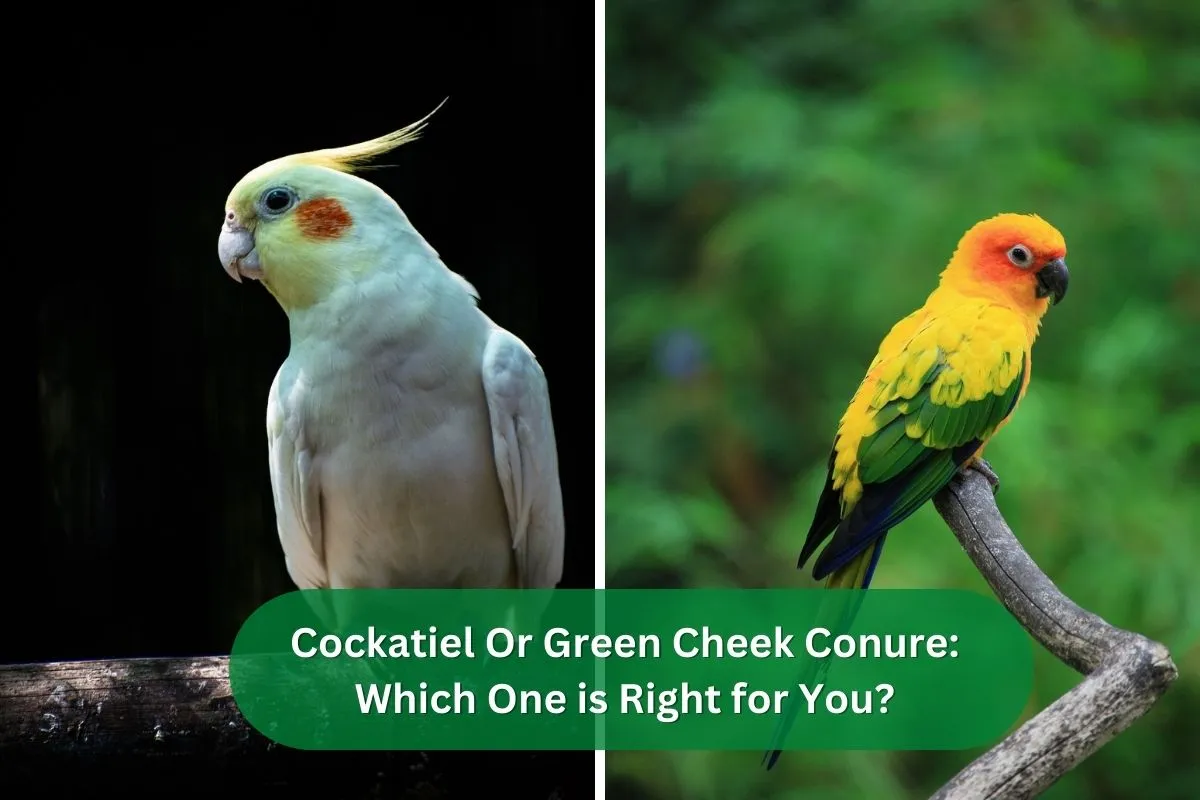When it comes to choosing a cockatiel or green cheek conure, there are many factors to consider. The cockatiel and the green cheek conure are two of the most common conures. They are both beautiful birds, but they have some key differences. Let’s consider some factors when deciding between a cockatiel and a green cheek conure.
Cockatiels are small, affectionate parrots native to Australia, while green cheek conures are native to South America. Cockatiels are typically smaller and less active than green cheek conures and have a reputation for being more laid-back and easier to tame. Green cheek conures are known for being energetic and playful but may require more attention and training to keep them well-behaved.
Read on to learn more about these birds before finally deciding which one is better for you.
Comparing size, lifespan, and personality traits of cockatiels and green cheek conures
| Cockatiel | Green Cheek Conure | |
| Size | Small | Small |
| Lifespan | 12-15 years | 15-25 years |
| Personality | Affectionate, laid-back | Energetic, playful |
| Training | Easier | More challenging |
| Intelligence | Moderate | High |
It is important to note that individual birds within a species can vary in size, lifespan, personality, and other traits, so it is always best to research and interact with a bird before deciding to adopt.
Are conures smarter than cockatiels?
It is generally believed that conures are more intelligent and have more advanced cognitive abilities than cockatiels. Conures are known for their high energy levels and playful nature, often leading to them being more active and curious than cockatiels.
They are also known for their ability to learn tricks and solve problems, which may be due to their higher level of intelligence. However, it is important to note that intelligence can vary significantly among individual birds within a species and that both cockatiels and conures can be intelligent and capable of learning.
It is also important to consider that intelligence is not the only factor when choosing a pet bird, as many other traits may be more or less important to different people.
Green Cheek Conure vs Cockatiel Noise
| Factors | Cockatiels | Green Cheek Conures |
| Noise Level | Moderate | High |
| Vocalization | Occasional | Frequent |
| Volume of Calls | Moderate | Loud |
Note: Noise level and vocalization can vary among individual birds and may also be affected by factors such as environment, diet, and training. It is important to consider the potential noise level of any pet bird before bringing one into your home.
Diet and Nutrition Needs: Cockatiels vs. Green Cheek Conures
Cockatiels and green cheek conures require a varied and balanced diet to stay healthy. A good diet for these birds should include a high-quality pellet or seed mix, fresh fruits and vegetables. In addition, it is essential to provide a source of calcium, such as cuttlebone or mineral block, and to offer a source of clean, fresh water at all times.
Space and Cage Requirements: Cockatiels vs. Green Cheek Conures
Cockatiels are smaller birds and typically require a cage at least 20 inches by 20 inches by 30 inches in size. Green cheek conures are slightly larger and may need a cage of at least 24 inches by 24 inches by 36 inches in size. It is essential to provide plenty of space for these birds to move around and plenty of toys and perches to keep them entertained.
Maintenance and Grooming: Cockatiels vs. Green Cheek Conures
Both cockatiels and green cheek conures require regular grooming to stay healthy and maintain their feathers. This may include regular beak and nail trimmings, as well as occasional baths or mistings to keep their feathers clean and hydrated. It is also important to regularly clean and disinfect the bird’s cage and accessories to prevent the build-up of bacteria and parasites.
Lifespan Comparison: Cockatiels vs. Green Cheek Conures
Cockatiels can live for an average of 15 to 25 years, while green cheek conures have a lifespan of approximately 10 to 25 years. It is important to provide proper care and nutrition to help ensure that your bird lives a long and healthy life.
Cost and Availability: Cockatiels vs. Green Cheek Conures
The cost of cockatiels and green cheek conures can vary depending on several factors, including age, breeding, and location. On average, cockatiels may cost slightly less than green cheek conures. Both species may be available from pet stores, breeders, or rescue organizations.
Is a conure better than a cockatiel?
It depends on your individual preferences. Cockatiels are smaller than green cheek conures, but they can make great pets. While cockatiels tend to be quieter, green cheek conures can be pretty vocal and playful. Is one smarter than the other? Both birds have unique personalities and intelligence levels, so it is hard to make an accurate comparison. Ultimately, it comes down to your individual preference and the time you are willing to devote to each species.
Is a green cheek conure a good first bird?
A green cheek conure can make an excellent first bird for a pet owner, particularly if the owner has plenty of time to devote to training and socializing with the bird. They are intelligent birds that are known for their playful personalities, but they also require plenty of attention from their owners. If you have limited time or space, then a cockatiel may be a better fit for your lifestyle. Conure and cockatiel together
Can a green cheek conure and cockatiel live together?
In most cases, keeping green cheek conures and cockatiels in separate cages is best. While they can coexist peacefully, the smaller size of a cockatiel can make them more vulnerable to aggression from a larger bird such as a green cheek conure. That being said, if you have experience with both species and can provide ample space and enrichment, it can keep both birds together in the same cage. Monitoring their interactions closely and creating a safe environment for both birds is essential.
Cockatiel Or Green Cheek Conure: Did I answer everything you need to know about?
When choosing between a cockatiel and a green cheek conure, there are many factors to consider. These may include the size of the bird, the potential noise level, the space and cage requirements, the maintenance and grooming needs, the lifespan, and the cost. It is important to carefully research both species and consider your own needs and lifestyle before deciding.

